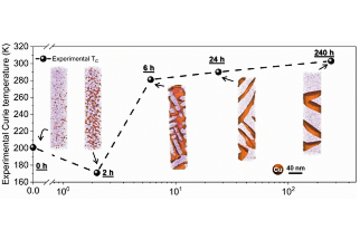All genres
1.
Journal Article
In-situ synthesis via laser metal deposition of a lean Cu–3.4Cr–0.6Nb (at%) conductive alloy hardened by Cr nano-scale precipitates and by Laves phase micro-particles. Acta Materialia 197, pp. 330 - 340 (2020)
2.
Journal Article
Laser additive manufacturing of copper–chromium–niobium alloys using gas atomized powder. International Journal of Materials Research 111 (7), pp. 587 - 593 (2020)
3.
Journal Article
The effect of Zr on precipitation in oxide dispersion strengthened FeCrAl alloys. Journal of Nuclear Materials 533, 152105 (2020)
4.
Journal Article
Steels in additive manufacturing: A review of their microstructure and properties. Materials Science and Engineering A: Structural Materials Properties Microstructure and Processing 772, 138633 (2020)
5.
Journal Article
Corrigendum to Multiscale investigations of nanoprecipitate nucleation, growth, and coarsening in annealed low-Cr oxide dispersion strengthened FeCrAl powder [Acta Mater. 166 (2019) 1–17]. Acta Materialia 180, p. 1 (2019)
6.
Journal Article
Stability of a model Fe–14Cr nanostructured ferritic alloy after long-term thermal creep. Scripta Materialia 170, pp. 134 - 139 (2019)
7.
Journal Article
Microstructural evaluation of a Fe–12Cr nanostructured ferritic alloy designed for impurity sequestration. Journal of Nuclear Materials 522, pp. 111 - 122 (2019)
8.
Journal Article
Multiscale investigations of nanoprecipitate nucleation, growth, and coarsening in annealed low-Cr oxide dispersion strengthened FeCrAl powder. Acta Materialia 166, pp. 1 - 17 (2019)
9.
Journal Article
Synthesis and stabilization of a new phase regime in a Mo–Si–B based alloy by laser-based additive manufacturing. Acta Materialia 151, pp. 31 - 40 (2018)
10.
Conference Paper
OFrac: An advanced nanostructured ferritic alloy fuel cladding for fast reactors. AISTech 2018 Iron and Steel Technology Conference and Exposition, Pennsylvania Convention Center, Philadelphia, PA, USA, May 07, 2018 - May 10, 2018. AISTech - Iron and Steel Technology Conference Proceedings 2018-May, pp. 1433 - 1435 (2018)
11.
Conference Paper
Ofrac: An advanced nanostructured ferritic alloy fuel cladding for fast reactors. 2018 Transactions of the American Nuclear Society, ANS 2018 and Embedded Topical Meeting Nuclear Fuels and Structural Materials, Marriott Philadelphia Downtown, Philadelphia, PA; USA, June 17, 2018 - June 21, 2018. Transactions of the American Nuclear Society 118, pp. 1433 - 1435 (2018)
12.
Talk
Analysing the effect of milling intensity on the nano-precipitate evolution in ODS FeCrAl alloys using atom probe tomography. MRS Fall Meeting , Boston, MA, USA (2017)
13.
Thesis - PhD
Laser Additive Manufacturing of Oxide Dispersion Strengthened Steels and Cu–Cr–Nb Alloys. Dissertation, RWTH Aachen University (2019)











